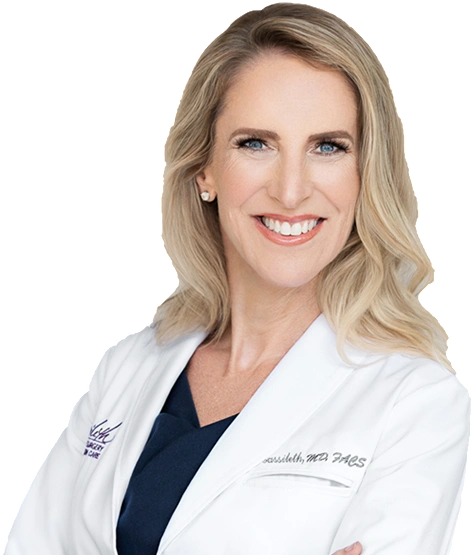
Breast Reconstruction
Inventor of Direct-to-Implant Breast Reconstruction in Los Angeles
Fat transfer is a widely and successfully used plastic surgery technique to reconstruct a breast after a lumpectomy or mastectomy. Breast reconstruction with fat transfer can also be used to correct tuberous breasts, Poland Syndrome, and natural asymmetries present in many women, where one breast is naturally smaller than the other.
Contact Cassileth Plastic Surgery about capsular contracture in Los Angeles, Beverly Hills, Santa Monica, and beyond.
Fat grafting is a powerful and effective tool that we use with many of our breast reconstruction
patients.1 With fat grafting, we can:
In mastectomy reconstruction, there is often a step off or an area where the breast contour looks unnatural. The top of an implant may show, the breast may feel cool to the touch, or rippling may be visible through the skin. Fat grafting adds natural thickness using your own body fat.2 Fat adds a layer of natural tissue that cannot be achieved by implants alone. Typically, the whole mastectomy area requires some graft, as it improves the skin quality, warmth, and texture. Additional fat can be grafted anywhere there is a divot, a dip, visible implant rippling, or any other area that would benefit. The fat grafting can be done at any time after the mastectomy reconstruction, from 6 months to 60 years. It also has benefits of improved comfort and softness, and gets rid of the feeling some women have of “always wearing a bra” or “feels uncomfortable all the time” that can come with implant based reconstruction.
For fat grafting as a sole method of reconstruction, first the mastectomy is performed with a small implant that acts as a spacer. Many of our patients that choose this option want to avoid silicone altogether, and we usually use a saline implant for these patients. The space allows the breast to maintain its basic shape without sticking down to the chest wall. The mastectomy can be skin and nipple sparing, with the incision under the breast, to create the best breast appearance. After the area has healed, typically 6 months, the implant size is decreased and the volume is replaced with fat. Each time, between 100 and 400cc of fat is grafted, depending on the volume that is safe for each patient. Eventually, the implant is removed. This may take one session of fat grafting for breasts that are small, and it may take more sessions for breasts that are larger.3 The final breast size does not need to be the same size as the original breast.
With a lumpectomy, a portion of the breast is removed where the breast cancer is located, and some normal surrounding tissue. Then the remaining breast tissue is radiated to help to prevent recurrence. This leaves the breast smaller, and also tighter, and higher than the other breast. The radiated breast can also feel painful, tense, and tight, because the radiation not only kills the more rapidly dividing cancer cells but injures the natural repair cells of the breast. This makes it hard for the breast to fully recover from the radiation itself, as the very cells that repair the radiation defect also are damaged by the radiation. Fat grafting for a radiated lumpectomy not only replaces that lost volume for the lumpectomy but also places new, safe mesenchymal cells that help heal the damaged tissue.
Browse our gallery to see examples of breast reconstruction with fat grafting.
Board-Certified Beverly Hills Plastic Surgeon, Breast Specialist, and Direct-to-Implant Breast Reconstruction Inventor
First, we look at the area that needs the fat grafting, and choose the goal volume to be transferred. Then, we choose a donor site. We select a site that remains a little fat even when you are thin. During surgery, the fat is taken from your body using low trauma liposuction, which is similar to liposuction but uses lower aspiration pressures. Fat is also often taken in smaller amounts and from more than one area to keep the donor sites normal in appearance (but a little thinner!). Incisions are hidden in natural creases and are approximately 3mm, which is very small. After the fat has been harvested, it is processed and purified. The final fat for transfer is pure solid fat cells placed into many 3cc syringes, where they are placed into the breast using blunt tiny cannulas that distribute the new living fat cells amongst the normal subcutaneous fat. With each pass of the cannula, only 0.1 – 0.2cc is placed, which keeps the fat in close contact with the perfused tissue. This minimizes the risk of fat necrosis by surrounding the newly placed fat with viable, supportive tissue. This technique is meticulous, taking about 1 hour per 100cc of fat transferred. At each session, the amount of fat in the breast can be doubled, allowing more gain after the first surgery if more than one session is desired.
Double-Board-Certified Beverly Hills Plastic Surgeon and Breast & Body Specialist
With almost no exceptions, fat transfer works. Critical steps, such as minimizing the fat outside the body, post-operative support of fat with diet and hyperbaric, small aliquot injection intra-operatively, and minimizing fat trauma, must be followed to the letter each and every time to get results. Remember that fat, however, is limited as to how much can be injected with every surgery. If too much fat is injected, this can also lead to poor blood flow to the newly placed fat and fat necrosis. A good rule of thumb is that patients can expect doubling of their natural fat thickness. This can be frustrating for patients with thin mastectomy flaps, as doubling of thin tissues still does not look like a real breast and allow for implant in one surgery. We will be setting your expectations at a realistic level after your physical exam, as the thickness of the natural tissue can be measured, and by using our Vectra, which allows us to know your exact implant to natural ratio.
Fat transfer is a relatively straightforward surgery, essentially combining low-trauma liposuction with needle-free injections. Breasts are pain-free, and the liposuction site is sore for less than one week. We usually perform the procedure as an outpatient, and patients require few or no pain medications. Dr. Cassileth will provide you with a compression garment to help your body mold to its new contours following liposuction and minimize any swelling in the area where fat was harvested.
It's important to avoid any activity such as sleeping on your stomach or wearing clothing that will compress the breasts for a minimum of 4 weeks following breast reconstruction with fat grafting to allow the transferred fat cells to integrate with existing tissue. Additionally, refrain from any high-impact activities for at least one month. Most patients are comfortable returning to work 3-5 following surgery for sedentary jobs and after one week for jobs that require movement.
Fat transfers have been used for twenty years to restore areas of the body affected by illness or injury or to improve the appearance of certain trouble spots that deflate with age. Successful fat grafting, however, is very technique dependent.4 There is a specific way that the fat must be harvested, processed, and transferred. Successful fat grafting involves moving living fat cells from a “harvest site” (area of fat) to a “donor site” (site that needs fat). Each year, our plastic surgeons perform hundreds of breast reconstruction surgeries involving fat grafting.
When Dr. Cassileth is performing breast reconstruction using fat grafting, the patient will choose a donor site where there is excess or unwanted fat from elsewhere on the body. Patient's typically choose areas with troublesome pockets of stubborn fat such as the stomach, flanks (love handles), or thighs.
No, because there are no incisions made on the breasts. The tiny ports made to insert the cannula heal with a virtually undetectable scar because Dr. Cassileth takes pains to hide the ports within the natural breast folds and measure only 2mm.
No, Dr. Cassileth will ensure that fat is taken from more than one area so that you look naturally thinner, and this avoids any divots or defects in the fat donor area.
You will retain around 80% of fat grafted into your breast and this transferred fat is permanent.
To find out precisely what fat grafting breast reconstruction options are available to you, and how best to achieve the look that you want, call our office at 310.651.6536 to make an appointment for a consultation, or click here send us a message.
Contact Cassileth Plastic Surgery about capsular contracture in Los Angeles, Beverly Hills, Santa Monica, and beyond.
Connect with us on social media! We pride ourselves on building real relationships with our patients near and far.

